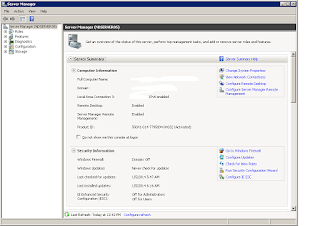About Windows Server 2008
Microsoft released multiple edition of "Windows Server 2008" .
You can purchase these edition for both 32 bit and 64 bit. In Server 2008 Microsoft introduced some new features, Hyper-V is one of them.
Hyper-V :- Hyper-V is a virtualization technology, in which we can run multiple operating system concurrently on the same system. Using Hyper a single server can act like multiple servers.
Hyper-V is only available for 64 bit operating systems.
Windows Server 2008 Editions
1.Windows Server 2008 Standard Edition :- This edition is for small and medium size organizations.
This is available for both, with and without Hyper-V.
With Hyper-V it support only one virtual server.
2. Windows Server 2008 Enterprise Edition :- This edition is for large organizations. This is available with and without Hyper-V. With Hyper-V it support up to four virtual servers. Enterprise edition also support clustering and hot swappable memory.
3. Windows Server 2008 Datacenter :- Datacenter edition is used for high end applications and large scale virtualization. This edition provides all features of enterprise edition with unlimited virtual server and hot swappable memory and processor feature.
4. Windows Server 2008 Web Edition :- This edition is designed on for web hosting.
New Security Features in Windows Server 2008
1.Bit Locker :- Bit locker is new feature introduced in server operating system. Bitlocker encrypt entire data volume and make it difficult to boot with another added volume.
2. NAP (Network Access Protection):- NAP protect our server from unhealthy or virus infected remote users.
3. Server Manager :- Server manager is a new console in which you can mange entire server roles and feature from single location.

4. Sever Core :- Server core allow to you only install required application to support for specific role.
Server core does not have GUI interface, It only have command line user interface.
5. Power Shell :- Power shell is a strong command line management tool. It allow you to combine commands and shell scripting.
You can use power shell with :
a). Exchange server
b). IIS
c). Active directory Domain services
d). Terminal server
e). Registory management
6. Read Only Domain Controller :- RODC host a read only copy of active directory database.
How To Install Windows Server 2008
1. Insert Windows Server 2008 DVD and restart computer
2. Press any key when system prompt "Press any key to boot from CD or DVD
3. Select language and click "Next"
4. Click "Install Now"
5. Select operating system Edition and click next
6. Accept the License Terms and click next
7. Click on custom
8. Select disk partition and click next
9. Installation Process Will Start..
10. Once installation process will complete, It will prompt for password change
11.Click OK to change password
12. Enter new password and enjoy.
Active Directory
Active Directory is a database that contains information about available resources in a domain forest. It allows client to find objects within a namespace. Anything that a active directory contain is considered as a object. An object can be any user, system, printer or any resource within Active Directory.
Domain Introduction
Domain is a logical group of object such as Users, computer, resources that share the same Active Directory database.
Domain Classification
1. Root Domain :- The Root domain is very first domain created in Active Directory forest. For example "Google.com" is a root domain
2. Child Domain :- Child domain shares the namespace of root domain. For example "translate.google.com" , "Maps.google.com".
3. Tree :- Tree is a group of domains that share the same namespace.
4. Forest:- Forest is the highest level of Active directory. Forest contain domain tree.








No comments:
Post a Comment